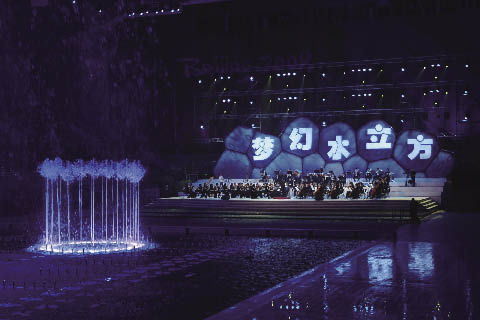| Growing Pains for Olympic Venues
By intern reporter ZHU HONG
TO cater to tourists and students during the summer holidays, the Beijing Olympic Green is now offering a package ticket, which includes admission not only to the hottest sites in the park such as the Bird's Nest and the Water Cube, but also the carnivals currently enlivening the grounds. The package can save tourists up to 50 percent off of single, separate entry fees.
Post-Games repurposing of the Olympic venues amounts to more than marketing; it includes the gradual refurbishment of the interior of the Bird's Nest for a start. Its third floor will be built into a loop-like Olympic-themed restaurant, displaying through photos and videos the Beijing Olympic Games preparation, spectacular competitive highlights, and venue construction; the Bird's Nest will have its own particular showcase of photos, videos and models.
The transformation of the Bird's Nest's facilities for commercial interests will remake an area of some 100,000 square meters. According to the current plan, 56 stores selling ethnic commodities and sports goods will be housed inside. Relevant officials of the Chaoyang District Tourism Bureau say that the interiors of the National Indoor Stadium, the Olympic Forest Park and some other venues will also be commercialized in the latter half of 2009.
With new retail and dining elements, as well as tour packages for the Olympic Green, the Olympic facilities once again earn the public's attention.
 |
| The National Aquatic Center hosted the debut of the symphony "Dream of the Water Cube," coupled with a musical water and light show. |
A Risk-sharing Operating Model
"In fact, the designs of the original Olympic venues had already taken into consideration post-Game utilization. Many competition venues were built in densely populated areas or universities, to be readily accessible to ordinary citizens," says Lin Xianpeng, executive director of Beijing Olympic Economy Research Association.
The Olympic venues are mainly concentrated in four zones in north and west Beijing. The central zone is in the Olympic Green, while the other three zones are located in western residential areas, northern scenic areas, and universities respectively. The central zone where the venues and facilities form a dense and unified "playground" is scaled for high-grade exhibitions, sports events and leisure or business activities. Wukesong Culture and Sports Center fills a gap in west Beijing, which has always lacked a large sports center, and is already being enjoyed by the community. The northern scenic area has become a tourism hotspot in its own right. Other venues scattered across six university campuses, mostly in northwest Beijing, enable students to enjoy considerably improved sports facilities.
Multi-investor models, risk-sharing and professional management have been introduced into the construction and operation of the Olympic venues, as they ease the government's burden with respect to their post-Games operation for the public good and as revenue-generators. The Beijing CITIC Consortium and the Beijing State-owned Assets Management Co., Ltd. (BSAM) jointly set up the National Stadium Operation Co., Ltd. to manage the Bird's Nest in terms of its financing, construction, management, operation, maintenance and handover. The company is also government-approved to hold the venue's exclusive management rights for 30 years. The Bird's Nest is the first Chinese stadium to follow the 3P or PPP model (Public-Private Partnership) of operation. This refers to government and private enterprise sharing the risk of operation. In contrast, the National Indoor Stadium, the National Conference Center and some others were Build-Operate-Transfer (BOT) projects, meaning that the investor is fully responsible for the design, financing, construction and operation of the project and eligible to profit from its use within a certain window of time, following which ownership is transferred to the government.
|
